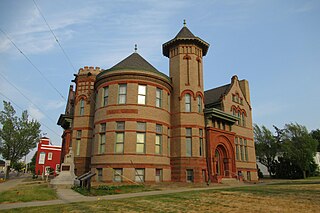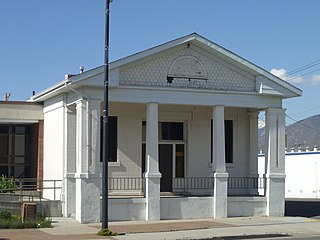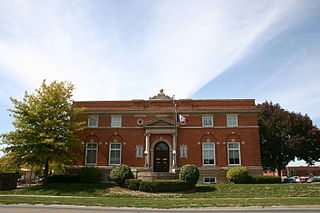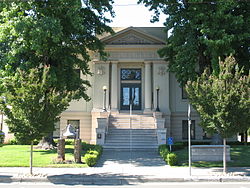
Brainerd Jones was an American architect who designed and built most of the architecturally significant buildings in Petaluma, California.

The Aitkin Carnegie Library is a Carnegie library in Aitkin, Minnesota, United States. It was designed by architects Claude & Starck and was built in the Classical Revival style. It was listed on the National Register of Historic Places in 1982.

The Sacramento City Library, also known as Central Branch, is part of the Sacramento Public Library system, and faces I Street in Sacramento, California near Sacramento City Hall.

The Carnegie Art Museum is a public art museum owned by the City of Oxnard, California in the building originally occupied by the Oxnard Public Library. The Neo-Classical building, located adjacent to Oxnard's Plaza Park, opened in 1907 as the Oxnard Public Library and was converted into an art museum in 1986. In July 1971, it became the first building in Ventura County and the first Carnegie library in California to be listed on the National Register of Historic Places.

The Woodland Public Library is the oldest, and one of the last functioning Carnegie-funded libraries in California. It is on the National Register of Historic Places and is a contributing property of the Downtown Woodland Historic District.

The Adrian Public Library is a historic structure located at 110 East Church Street in downtown Adrian, Michigan. Originally used as a library, it was designated as a Michigan Historic Site on December 14, 1976, and later listed on the National Register of Historic Places on December 6, 1977. It is located within the Downtown Adrian Commercial Historic District and adjacent to the Adrian Engine House No. 1. Today, the building houses the Lenawee County Historical Society Museum.

The Carnegie Free Library in Eureka, California was built in Classical Revival Style in 1902. It was listed on the National Register of Historic Places in 1986, and currently houses the Morris Graves Museum of Art.

The Carnegie Museum of the Keweenaw in Houghton, Michigan, is a non-collecting museum that houses changing exhibits about local cultural and natural history.

The Smith County Historical Society, housed in the Carnegie Library, is located at 125 S. College Street in the city of Tyler, Smith County, Texas, U.S. It was built in 1904 as the Carnegie Public Library, and added to the National Register of Historic Places listings in Smith County, Texas in 1979. When Tyler built a new public library, the Carnegie building was leased to the Smith County Historical Society and continues to operate as a museum and archives.

The Carnegie Library in Anaheim, California is a Carnegie library building built in 1908. The Classical Revival style building was designed by John C. Austin, and opened in 1909.
The Carnegie Library Building in Carroll, Iowa, United States, is a building from 1905. The 60-by-38.5-foot structure was designed in the Prairie School style by Omaha architect Thomas R. Kimball. The Carnegie Corporation of New York had accepted Carroll's application for a grant for $10,000 on February 12, 1903. It was listed on the National Register of Historic Places in 1976.

The Perry Carnegie Library Building, also known as the Carnegie Library Museum, is a historic structure located in Perry, Iowa, United States. The Perry Library Association was established in 1894, and William Tarr served as its first librarian. Andrew Carnegie accepted Perry's application for a grant for $10,600 on January 13, 1903. The Des Moines architectural firm of Liebbe, Nourse & Rasmussen designed the Neoclassical building that was built by local contractor Courtney and Bolt. It opened in September 1904 was dedicated on December 10.

The Hollister Carnegie Library is located on 375 Fifth Street in Hollister, California, US. Established in 1912 as a Carnegie library, decades later, it was re-purposed as a city hall. The building is part of the downtown's National Register-listed historic district, and was entered itself into the National Register on March 26, 1992.

The Tooele Carnegie Library, located at 47 E. Vine St. in Tooele, Utah, was built in 1911 and includes Classical Revival architecture. It was listed on the National Register of Historic Places in 1984.

The Carnegie Free Public Library, also known as the Carnegie Town Hall, is a historic Carnegie library located at 235 W. 10th St. in Sioux Falls, South Dakota. The library was built in 1903 through a $25,000 grant from the Carnegie Foundation. Architect Joseph Schwartz designed the building, a Romanesque Revival structure with Neoclassical influences. The library was built from locally quarried quartzite, a popular local building material at the turn of the century. While the building's massive form and rough-hewn stone exterior are Romanesque, it features a Greek pediment above the entrance supported by four pilasters on either side of the doorway. The building represents the only use of Classical details in a quartzite building in Sioux Falls.

The Carnegie Library at Livermore, California, opened in 1911 and continued in use as a library until 1966. It now hosts a historical museum and art gallery. The building was designed by William H. Weeks in the Greek Revival style and is included on the National Register of Historic Places. A weekly farmers' market takes place in the surrounding park.

Laurens Carnegie Free Library is a historic building located in Laurens, Iowa, United States. It was designed by the Des Moines architectural firm of Wetherell and Gage and completed in 1910. The Carnegie Corporation of New York had accepted the application for a grant from Laurens' literary association for $3,800 on February 6, 1907. The Mission Revival structure measures 42 by 22.5 feet, and has a projecting pavilion for the main entrance. An addition was built onto the rear of the building in 1955. The building now houses the Pocahontas County Historical Museum. It was listed on the National Register of Historic Places in 1974.

Oskaloosa Public Library is a facility located in Oskaloosa, Iowa, United States. Construction of the library was launched in 1902 with a grant from the Carnegie Corporation of New York. The building was added to the National Register of Historic Places in 1991.

The Marion Carnegie Public Library is a historic building located in Marion, Iowa, United States. The Marion Federation of Women's Clubs was established in 1901 with the purpose of organizing a public library. Adeliza Daniels was the primary force behind the organization, and she contacted Andrew Carnegie to donate funds for the building. After he agreed to a grant of $11,500, the Cedar Rapids architectural firm of Dieman and Fiske designed the brick Neoclassical building. Cedar Rapids contractor A.H. Conner was responsible for construction. It is a single-story structure built over a raised basement and a proment pedimented main entrance. The new library was dedicated on March 16, 1905, and served the community in that form until 1957. In that year the auditorium in the basement was remodeled into a children's reading room. A three-story addition, which doubled the size of the building, was completed in 1961. The building was individually listed on the National Register of Historic Places in 1994. The Marion Public Library has subsequently moved to a new facility, and the Carnegie building is now part of the First United Methodist Church complex. In 2009 it was included as a contributing property in the Marion Commercial Historic District.



















